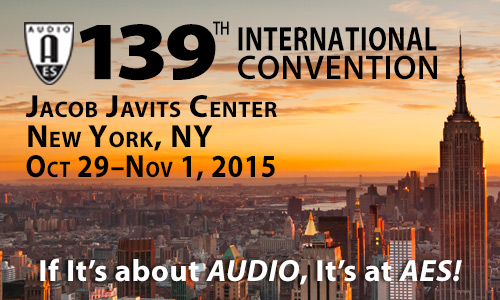
AES New York 2015
Paper Session P5
P5 - Perception—Part 1
Thursday, October 29, 2:30 pm — 5:00 pm (Room 1A07)
Chair:
Jon Boley, GN ReSound - Chicago, IL, USA
P5-1 Detection of High-Frequency Harmonics in a Complex Tone—Wesley Bulla, Belmont University - Nashville, TN, USA
Prior investigations have generally failed to confirm or deny the influence of high-frequency harmonics contained in musical sounds. Embedded within this experiment were two listening tests: one investigating threshold for differences in timbre, and thus, participant ability, and another seeking to find an influence of high-frequency harmonic content on timbre perception. Based on the premise that harmonics out of the range of auditory detection influence the resultant waveform and therefore may alter the percept of a sound’s tonal character, this study found no evidence that capable listeners noticed an effect of high frequency harmonics.
Convention Paper 9380 (Purchase now)
P5-2 Towards a Perceptual Model of “Punch” in Musical Signals—Steven Fenton, University of Huddersfield - Huddersfield, West Yorkshire, UK; Hyunkook Lee, University of Huddersfield - Huddersfield, UK
This paper proposes a perceptual model for the measurement of “punch” in musical signals. Punch is an attribute that is often used to characterize music or sound sources that convey a sense of dynamic power or weight to the listener. A methodology is explored that combines signal separation and low level parameter measurement to produce a perceptually weighted “punch” score. The parameters explored are the onset time and frequency components of the signal across octave bands. The “punch” score is determined by a weighted sum of these parameters using coefficients derived through a large scale listening test. The model may have application in music information retrieval (MIR) and music production tools. The paper concludes by evaluating the perceptual model using commercially released music.
Convention Paper 9381 (Purchase now)
P5-3 Factors That Influence Listeners’ Preferred Bass and Treble Levels in Headphones—Sean Olive, Harman International - Northridge, CA, USA; Todd Welti, Harman International Inc. - Northridge, CA, USA
A listening experiment was conducted to study factors that influence listeners’ preferred bass and treble balance in headphone sound reproduction. Using a method of adjustment a total of 249 listeners adjusted the relative treble and bass levels of a headphone that was first equalized at the eardrum reference point (DRP) to match the in-room steady-state response of a reference loudspeaker in a reference listening room. Listeners repeated the adjustment five times using three stereo music programs. The listeners included males and females from different age groups, listening experiences, and nationalities. The results provide evidence that the preferred bass and treble balances in headphones was influenced by several factors including program, and the listeners’ age, gender, and prior listening experience. The younger and less experienced listeners on average preferred more bass and treble in their headphones compared to the older, more experienced listeners. Female listeners on average preferred less bass and treble than their male counterparts.
Convention Paper 9382 (Purchase now)
P5-4 Identifying and Validating Program Material: A Hyper-Compression Perspective—Malachy Ronan, University of Limerick - Limerick, Ireland; Nicholas Ward, University of Limerick - Limerick, Ireland; Robert Sazdov, University of Limerick - Limerick, Ireland
Two listening experiments were conducted to assess: (i) the effect of program material on six sound quality dimensions and (ii) the effect of 20 dB of compression limiting on distraction. Thirty-five participants completed two experiments using a MuSHRA style interface. The experimental results demonstrate that program material significantly affected dimension and distraction ratings. Dimension ratings were influenced by prior listening experience while distraction ratings related to audible artifacts in different program material. Program material from the same artist was rated similarly for distraction in two-thirds of the dimensions suggesting a possible correlation between production aesthetics and audible artifacts. It is concluded that validating program material is a necessary precaution to avoid distracting perceptual cues generated by the process of dynamic range compression.
Convention Paper 9383 (Purchase now)
P5-5 Validation of Experimental Methods to Record Stimuli for Microphone Comparisons—Andy Pearce, University of Surrey - Guildford, Surrey, UK; Tim Brookes, University of Surrey - Guildford, Surrey, UK; Martin Dewhirst, University of Surrey - Guildford, Surrey, UK
Test recordings can facilitate evaluation of a microphone's characteristics but there is currently no standard or experimentally validated method for making recordings to compare the perceptual characteristics of microphones. This paper evaluates previously used recording methods, concluding that, of these, the most appropriate approach is to record multiple microphones simultaneously. However, perceived differences between recordings made with microphones in a multi-microphone array might be due to (i) the characteristics of the microphones and/or (ii) the different locations of the microphones. Listening tests determined the maximum acceptable size of a multi-microphone array to be 150 mm in diameter, but the diameter must be reduced to no more than 100 mm if the microphones to be compared are perceptually very similar.
Convention Paper 9385 (Purchase now)
